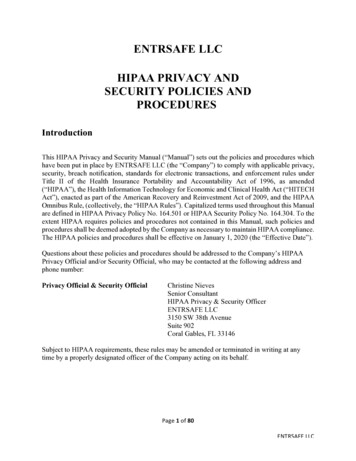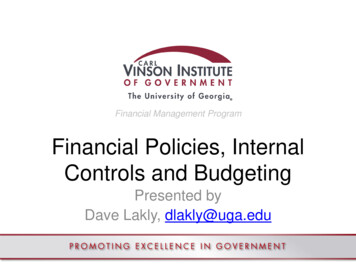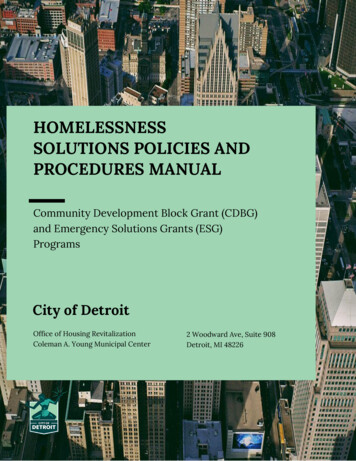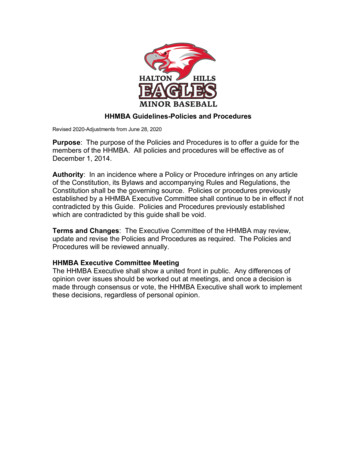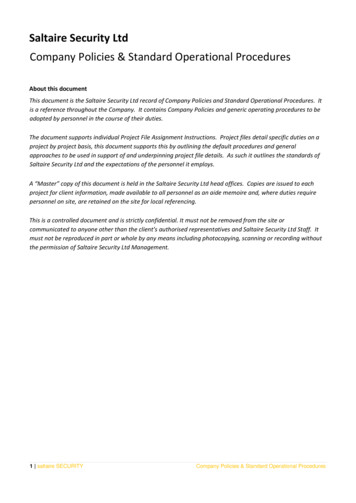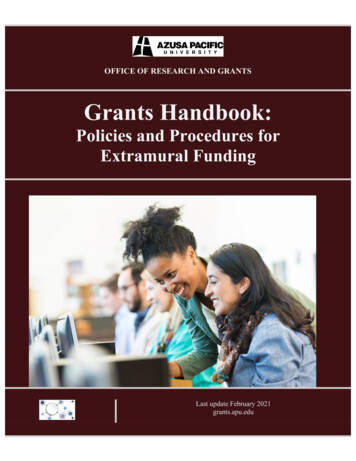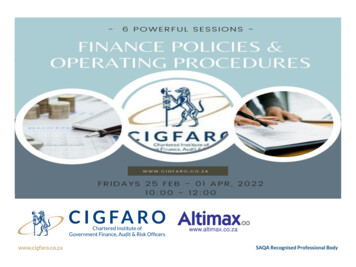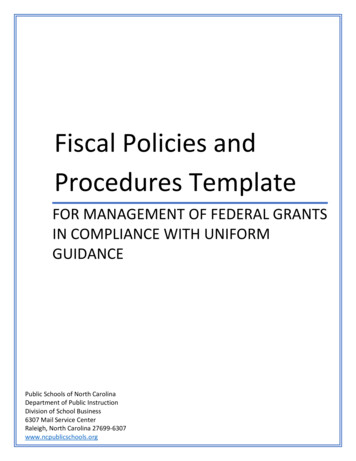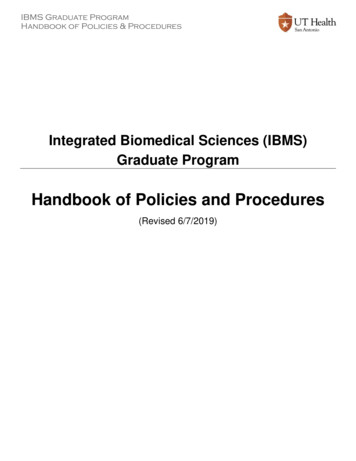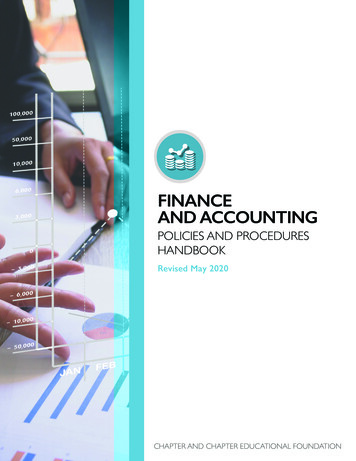
Transcription
FINANCEAND ACCOUNTINGPOLICIES AND PROCEDURESHANDBOOKRevised May 2020Issued June 2017CHAPTER AND CHAPTER EDUCATIONAL FOUNDATION
CONTENTSINTRODUCTION.4CHAPTER OPERATIONS.5Organizational Over view. . . 5OPERATIONAL GUIDELINES . . .6Bank Accounts. 6Budgeting. . . 6Chapter Annual Report. . . 7Chapter Records. 8Conflicts of Interest. . 9Contracts and Signing Authority. . . 9Credit Cards. 10Financial Reports. . . 10Fiscal Year. 10Management Ser vices Company. 10DUTIES OF THE CHAPTER TREASURER.11CHAPTER TAXES.12Federal Tax Returns. 12Maintaining Tax Exempt Status. . . 13Qualified Donations. . . 13MISCELLANEOUS.14Accounting Records Back-up Procedures. 14Accounting Method. 14Accounts Receivable Write-Off Procedures, Authority, and Collections. 14Bank Reconciliations. . 14Bartering. 14Bid Requirements. 152AFCEA International Proprietary and Confidential
Board-Designated Funds. 15Capitalization. . . 15Chart of Accounts. 15Check Deposits . . . 15Check Disbursements. 15Check Endorsement/Stamp. 16Check Signers. . . 16CPA Firms and Audited Financial Statements. 16Deferred Revenues. 17Depreciation and Amortization. 17Document Protection. 17Endowment or Restricted Funds. 17Finance Committees. 17Hotel Points. 17Insurance. 18Investment Policy. . 18IRS Form 990 Public Access. 18Lobbying. . . 18Mailing List Sales. 18New Vendors . . . 18Prepaid Expenses. 18Records Retention and Destruction. 18Requests for New Policies and Procedures. 19Segregation of Duties. 19Voided Checks. . . 19Write-off of Old Checks. . . 19AFCEA International Proprietary and Confidential3
INTRODUCTIONChapters are the foundation of AFCEA International, and the worldwide chapter structure is the keyto the success of the association. Though many changes have occurred over the nearly 75 years sinceAFCEA began, the constant and the bedrock of the association’s success have always been the chaptersand the members.Within each chapter, the leadership is instrumental in carrying out AFCEA’s mission, in implementinglocal programs, and in supporting the global goals and objectives of AFCEA International. Therefore, itis critical that chapter leaders understand their roles and responsibilities, their legal and ethical requirements, and their fiduciary liabilities in carrying out the duties of their positions.This handbook is a compilation of guidelines, suggestions, and best practices for day-to-day financial operations, and chapter leaders should use this handbook, the Chapter Officer Handbook, and the AFCEAInternational By-Laws as operating guides.Unless specifically stated, the use of “chapter” shall mean both a chapter and a chapter educationalfoundation.If you have any suggestions or recommendations regarding the content of the handbook, please contactAFCEA International, Chapter Services at 703-631-6242.4AFCEA International Proprietary and Confidential
CHAPTER OPERATIONSDedication and attention to detail are requirements for planning, organizing, and operating a successfulchapter. The AFCEA chapter, providing services to its members and community, is the cornerstone ofAFCEA’s structure and its most valuable resource.The chapter Board of Directors is the governing body, and they are responsible for the finances of thechapter. The Treasurer is the elected officer who maintains the financial records of the chapter and whois responsible for reporting those results to the Board.Fiscal and fiduciary responsibility and liability apply to every chapter and chapter educational foundation regardless of the size or scope of their operations. Chapter officials are the stewards of AFCEAmember’s money, and they answer to the membership on how they use the funds entrusted to theassociation.ORGANIZATIONAL OVERVIEWAFCEA is a chapter based association. Chapters are strategically located near government and militaryinstallations to facilitate interaction among government and industry and to match government needswith industry solutions.The chapter and the chapter educational foundation are two separate and distinct legal entities.Chapters operate under the guidelines of the AFCEA International By-Laws, and they host activities to include events, member luncheons, speaker series, and other activities.Chapter educational foundations are formed by the chapter to solicit and collect donations tosupport educational scholarships and awards for students and teachers in STEM related fields.Each entity has its own Employer Identification Number (EIN), and each entity is required tomaintain its own separate accounting records and bank accounts. The chapter and chaptereducational foundation are both tax exempt entities. The chapter is tax-exempt under InternalRevenue Code (IRC) Section 501(c)(6), and the educational foundation is exempt under IRCSection 501(c)(3). Both entities must file their own, separate Form 990 tax return.The chapter and chapter educational foundation’s tax exempt statuses are secured by AFCEA International Headquarters through group exemptions with the Internal Revenue Service (IRS). When a newchapter is issued a charter by AFCEA International Headquarters, the AFCEA chief financial officer(CFO) will provide the chapter with its EIN. If the chapter stands up an educational foundation, theAFCEA CFO must be involved in securing the EIN so the proper forms can be filed with the IRS. Thiswill automatically grant the educational foundation tax exempt status.A chapter or chapter educational foundation should not file itself for its tax exempt status. AFCEAHeadquarters will secure the status under the applicable group exemption, and there is no cost to thechapter. If an entity files for tax exempt status directly, there is a 400 user fee.AFCEA International Proprietary and Confidential5
OPERATIONAL GUIDELINESBANK ACCOUNTSAs the chapter is being formed, bank accounts should to be opened for the chapter and the chapter educational foundation. To assist with chapter leadership transition and for general oversight, the RegionalVice President should be included on the signature card for all accounts.Each entity must have its own separate bank account(s) under its own respective EIN. A chapter or theeducational foundation may each have multiple accounts, for instance a checking account and a moneymarket account. Regardless of the number or types, bank accounts must be separate and distinct fromeach other: Chapter accounts must be opened with the chapter EIN, and educational foundation accounts must be opened with the foundation EIN.Do not comingle chapter and educational foundation funds in the same bank account.Revenues received from chapter operations (events, luncheons, etc.) must be deposited into the chapterbank accounts. Donations received for the educational foundation must be deposited into the educational foundation bank accounts. Donations to the educational foundation are qualified charitable donations, so the donor may take a tax deduction for the contribution. This is one of many reasons why thefunds must always be deposited into the proper account.Best Practices: Look at various banks to see if their services meet your operating requirements. Be sure to tell thebank that the chapter is tax exempt. Many banks will waive fees for non-profits. Banks are always looking to network. The bank may be a lead for a chapter sponsorship or they mayfund a scholarship for a chapter’s educational foundation. Monthly bank reconciliations must be timely—completed within a week of receiving the bank statement—to ensure proper controls over cash. Deposits must be made timely, intact, and to the proper account.BUDGETINGAnnually, the chapter and educational foundation should prepare an operating budget that is approvedby the respective Board of Directors. The budget should include all sources of revenues and expenses,be realistic, and be used as a management tool to gauge operations and results. The budget processshould be a collaborative effort with the Treasurer in the lead. The Treasurer should receive input fromall chapter leaders and chairs who oversee various chapter functions, such as events, member services(luncheons, meetings, etc.), YAC programs, and scholarships and awards programs.The budget should be developed by each respective functional area and in enough detail to be useful inmanaging the activities of the chapter. For example, each event should have its own individual budget,and then all events can be aggregated into one “Events” budget. Monthly meetings (speaker series, lunchand learn talks, etc.) should be budgeted individually and then aggregated into one functional budget, forexample a budget called “Member Services.” The titles can be at the discretion of each chapter, but thebudget needs sufficient detail to provide leadership with measurement tools to track results.Educational foundation budgets need to include line items for various types of donations (individual, corporate, chapter, etc.) and line items for various expenses to include scholarships by type (STEM, ROTC,etc.), awards (students, teachers, school, etc.) and any other related expenses.6AFCEA International Proprietary and Confidential
The budget must be realistic, measurable, and balanced each year. Excess net revenues over expenses(net income) can be budgeted with the goal of establishing, or adding to, the chapter reserve fund. Thereserve fund provides a safety net to cover potential operating contingencies, such as covering an eventcancellation or funding a chapter initiative or new program.Many non-profit reference guides suggest a target reserve of 50 percent of the annual budgeted expenses. The chapter Board and Treasurer need to assess what a realistic amount is for the chapter reservefund. The educational foundation should do the same. The foundation’s reserve could be used to fundcommitted scholarships in years when donations may have decreased.Best Practices: The budget process should allow enough time to build a draft budget properly; review and modifyit as needed; and have it approved for implementation at the start of the operating year (whether afiscal or calendar year). Monthly financial reports should be prepared and include actual results compared to the budgetyear-to-date. Variances from the budget should be explained. Various budgeting tools are available to chapters, such as Excel or QuickBooks. The chapter canchoose the best tool to build its budget, but most critical is the development, approval, and implementation of the annual budget.CHAPTER ANNUAL REPORTEach chapter will submit an Annual Report to AFCEA Headquarters no later than March 1st of each yearfor the previous calendar year. All chapter annual reports are submitted electronically via the AFCEA portal.The Annual Report serves two important purposes: (1) It helps maintain the chapter’s tax exempt status,and (2) it serves as a reporting and analysis tool for the regional vice president and AFCEA chapter supportpersonnel to ascertain the chapter’s membership status, programs, financial position, and general health.As part of the annual report, chapters must upload their most current Form 990 tax return. The annualreport is prepared using calendar year information that may not always coincide with the chapter’s taxreporting period (calendar year compared to fiscal year). It is not necessary to make adjustments if achapter is in this situation. The Form 990 tax return can be uploaded at any time. If the fiscal year endsSeptember 30, and the Form 990 is complete in January, the return can be uploaded at that time withoutwaiting to submit the annual report.Chapters that do not submit an annual report will not be eligible to receive any AFCEA InternationalAwards.Beginning in Fiscal Year 16, the AFCEA International Board of Directors and the AFCEA International Educational Foundation Board of Directors implemented a six (6) percent assessment on chapters payable tothe AFCEA International Educational Foundation.This is an annual assessment from the chapter and shouldbe included in the chapter budget and reported on its Annual Report. The 6 percent assessment is paid tothe AFCEA International Educational Foundation annually, no later than June 1st. This assessment was putin place following multiple meetings and discussions with the regional vice presidents and chapter leaders.The assessment is based on the net revenue raised for educational purposes for the chapter and chaptereducational foundation. Following are a few scenarios that explain what is reported in the Annual ReportAFCEA International Proprietary and Confidential7
and how to calculate the net amount to be assessed the 6 percent: Chapter Event:o The chapter holds an event (IT day, conference, golf outing, fun-run, etc.). The gross receiptsfrom the event are 150,000, and related event expenses are 120,000. The net from the eventis 30,000, and the 30,000 is transferred to the educational foundation to fund scholarshipsand grants. This 30,000 is subject to the 6 percent assessment, or 1,800.o Assume the same scenario except from the 30,000 the chapter keeps 10,000 in chapter reserves and transfers 20,000 to the educational foundation. In this case the 20,000 is subjectto the 6 percent assessment, or 1,200. Other funding sources:o Assume during the fiscal/operating year that the chapter executes monthly luncheons, collectssponsorships for these luncheons, and has other sources of revenues.The chapter agrees to donate 25,000 to its educational foundation from chapter cash reserves. The 25,000 is subjectto the 6 percent assessment or 1,500. These funds are now in the educational foundation andare available for scholarships and grants. Note the assessment is based on net revenues and not what is paid out in scholarships or grants inany given year.o In the other funding sources scenario, assume that in the year of transfer that 15,000 of the 25,000 is disbursed. The following fiscal year, no revenues are raised for education, and the remaining 10,000 is paid out. Because there was no new money raised, there is no assessment inthe second year. A total of 25,000 has been paid over two years, but for tracking purposes, theassessment has already been paid so there’s no need to track disbursements over multiple years.CHAPTER RECORDSThorough and accurate accounting and tax records must be maintained for all chapter and educationalfoundation activities and annual tax filings. In addition to the necessary financial records, tax returns, andminutes of Board meetings, each committee chairperson should provide a detailed report on his or hercommittee’s activities. Such information as attendance at special events, cost of activities, revenues andother relevant information should be included in these reports. The compiled information greatly simplifies planning for a new committee chairperson and ensures a smooth transition of leadership positions.It is essential that all financial records, tax returns, and applicable documentation be maintained by theTreasurer. The Treasurer must keep accurate and complete accounting records and supporting workpapers for all tax filings. This is part of the fiduciary responsibilities of chapter leaders, and the betterthe recordkeeping, the easier the transition from one Treasurer to another.Chapters can develop their own methods of maintaining and storing accounting and tax records, but thecritical element is to have a plan in place to maintain the information. Backups of electronic data shouldbe done periodically. A Records Retention Guide is provided, and it serves as a guideline for the lengthof time records should be maintained.Chapter leadership should ensure that the new officers receive copies of applicable records and documentation as soon as possible so they can familiarize themselves with chapter operations.General Recordkeeping: All cash receipts should be recorded and deposited as soon as possible, and all expenditures shouldbe recorded at the time they are made. Chapter accounting records should be balanced and reconciled monthly.o Ideally, accounting should be done on the accrual basis of accounting, which recognizes incomeand expenses in the month they are incurred. For example, if a chapter executes an event in8AFCEA International Proprietary and Confidential
oMay, revenues received and expenses paid prior to May will be recorded as deferred incomeand prepaid expenses, respectively. In May, these revenues and expenses are recognized as incurred, along with any other transactions executed in May for that event.The other option to account for transactions is the cash basis of accounting. The cash basisrecords revenues when received and expenses when paid, regardless of when the revenues andexpenses are actually incurred. The concern with the cash basis accounting is timing. Revenues are typically received priorto an event, and expenses are paid afterward. Significant revenues could be recorded inthe months prior to an event that inflate the bottom line. Then after the event, when theexpenses are paid, the bottom line is reduced. With cash basis accounting, the potentialexists for significant swings in the bottom line from month to month.CONFLICTS OF INTERESTChapter leaders must avoid conflicts of interest, whether real or perceived. Related party transactionsshould be avoided, and in rare situations where they are entered into, full disclosure of the transaction(s)must be reported to the leadership and Board.CONTRACTS AND SIGNING AUTHORITYAll contracts executed by the chapter must be in the name of the chapter. Terms and conditions shouldbe clearly defined and acceptable to the chapter without placing undue burdens or financial risks on thechapter.The AFCEA International Board of Directors instituted a contract review policy for chapters and chapter educational foundations for all contracts valued at more than 25,000. The policy, as stated in theAFCEA International By-Laws, Article XII, Section 5, states:“No Chapter shall have signatory authority to obligate AFCEA International or the Chapteron any contractual obligation in excess of 25,000. Any contract with a value or expensein excess of 25,000 must be reviewed and executed by AFCEA International in a mannerconsistent with the AFCEA International By-laws and Policy.”The chapter and chapter educational foundation must forward contracts in excess of 25,000 to theexecutive vice president/CFO of AFCEA International for contract review with legal counsel as needed.Best Practices: Carefully consider all terms and conditions of the agreement:o Are required deposits reasonable and adequately timed?o Are attrition provisions reasonable?o Are all costs associated with the agreement clearly detailed in the agreement? Has the pricing been negotiated with the venue or vendor?o Are there favorable termination provisions: No penalty is incurred if a similar event is booked and executed within an agreed to timeperiod Any penalty is reduced/eliminated if the space is resold by the venueo Force Majeure – does it cover extenuating circumstances such as a cancellation by the government?AFCEA International Proprietary and Confidential9
CREDIT CARDSChapters may establish a merchant account that allows the chapter to accept credit card transactions.The chapter should evaluate multiple providers as fees can vary significantly. AFCEA International canassist with this process and securing competitive fees.FINANCIAL REPORTSMonthly financial reports should be prepared by the Treasurer and presented to the Board of Directorsfor review.The finance report should include the Statement of Financial Position (Balance Sheet) and theStatement of Activities (Income Statement). Revenues and expenses should be compared to the budgetto date with explanations being provided for material variances. At the end of the operating/fiscal year,an annual report should be prepared for the board to review. This statement is the basis for the annualForm 990 filing.FISCAL YEARWhen a new chapter is organized, a fiscal year must be established. Consideration must be given toselecting the fiscal year because once selected, it takes IRS approval to change.AFCEA International Headquarters operates on a fiscal year that is in line with the U.S. federal government: October 1 through September 30. A chapter may use that same fiscal year, the calendar year, oranother cycle that best coincides with chapter operations, for example, July 1 to June 30. The chapterand its chapter educational foundation should use the same fiscal reporting period.MANAGEMENT SERVICES COMPANYSome larger chapters have engaged a management services company to handle day-to-day operations,events management (registration, exhibits, patrons and sponsors, exhibit layout, monthly luncheons, etc.),and accounting functions. The agreement between the chapter and the management service companymust clearly define the roles and responsibilities of the service company. The chapter also needs to haveinternal controls in place to ensure proper accounting of all transactions. Additional considerationsinclude: Data protection and ownership – the agreement must clearly state that member information,AFCEA and chapter logos, intellectual property, etc. are owned by AFCEA and the chapter. Access toany of this information by an authorized chapter officer must be provided by the services companyin a timely manner. The services company cannot execute contracts for the chapter.They can assist in negotiating terms,but they cannot sign agreements on behalf of the chapter. The agreement must include a transition plan for information maintained and services provided bythe services company in the event they are replaced by another provider or if the chapter decidesto disengage from their services.o Renewal terms should also be clearly defined in the agreement. Pricing should be competitive for the services being provided. Whenever possible multiple quotesshould be solicited by the chapter to ensure fair pricing.o Ask for and check references provided by the company. Ask for contact information of clientswho disengaged from the service provided and find out why they disengaged.10AFCEA International Proprietary and Confidential page
POLICIES AND PROCEDURES HANDBOOK Issued June 2017 CHAPTER AND CHAPTER EDUCATIONAL FOUNDATION Revised May 2020. 2 AFCEA Internationa Proprietary and Confidentia . Various budgeting tools are available to chapters, such as Excel or QuickBooks. The chapter can
